FINAL EXAM HSCI 103
1/72
There's no tags or description
Looks like no tags are added yet.
Name | Mastery | Learn | Test | Matching | Spaced |
|---|
No study sessions yet.
73 Terms
Which structure of the nephron reabsorbs the most substances?
proximal convoluted tubule
3 multiple choice options
This term means the return of substances into the blood stream from the filtrate.
reabsorption
3 multiple choice options
Fluid flowing from point G in the figure will go to which structure next?
I
3 multiple choice options
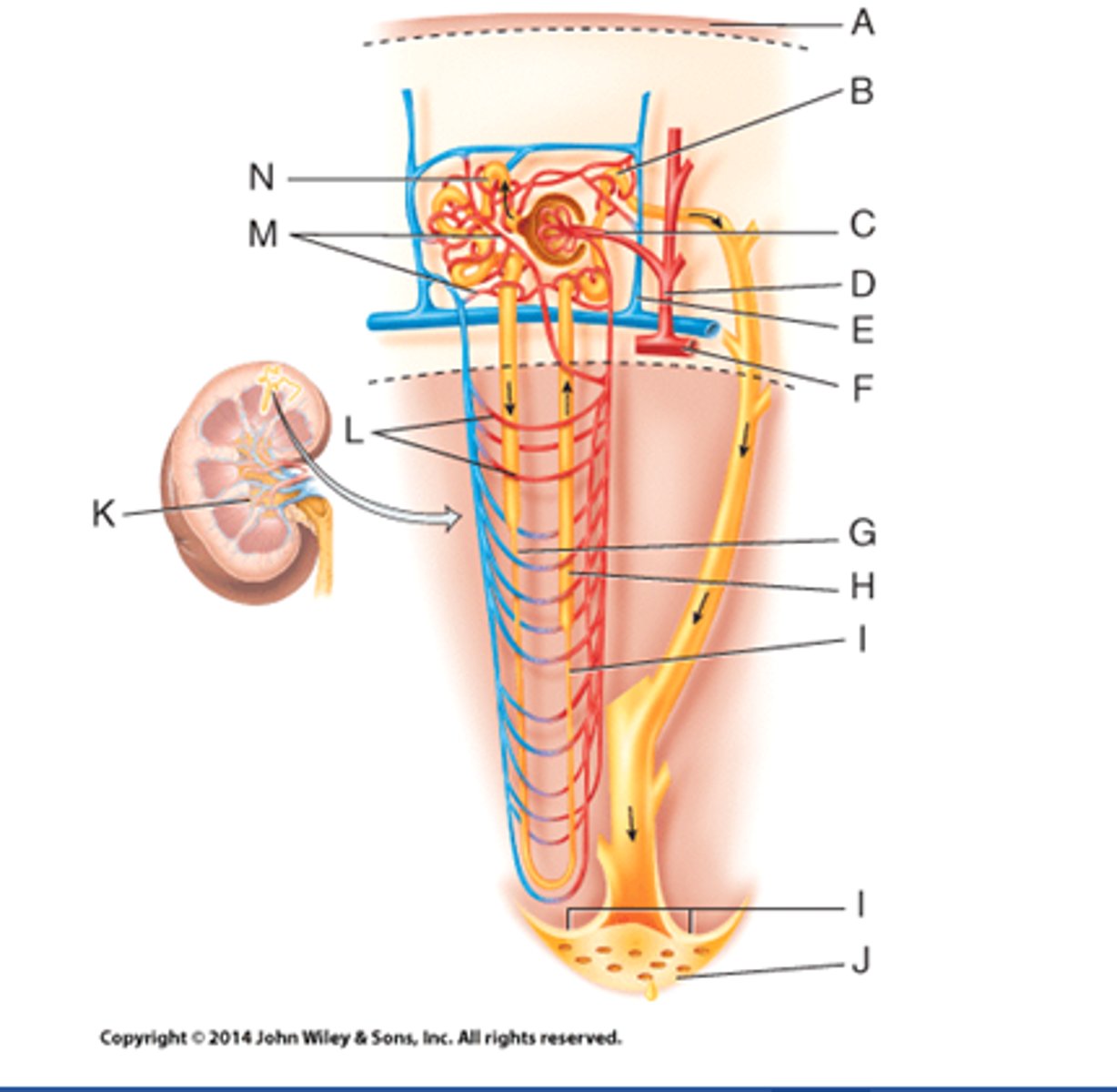
What two structures comprise the renal corpuscle?
A and B
3 multiple choice options
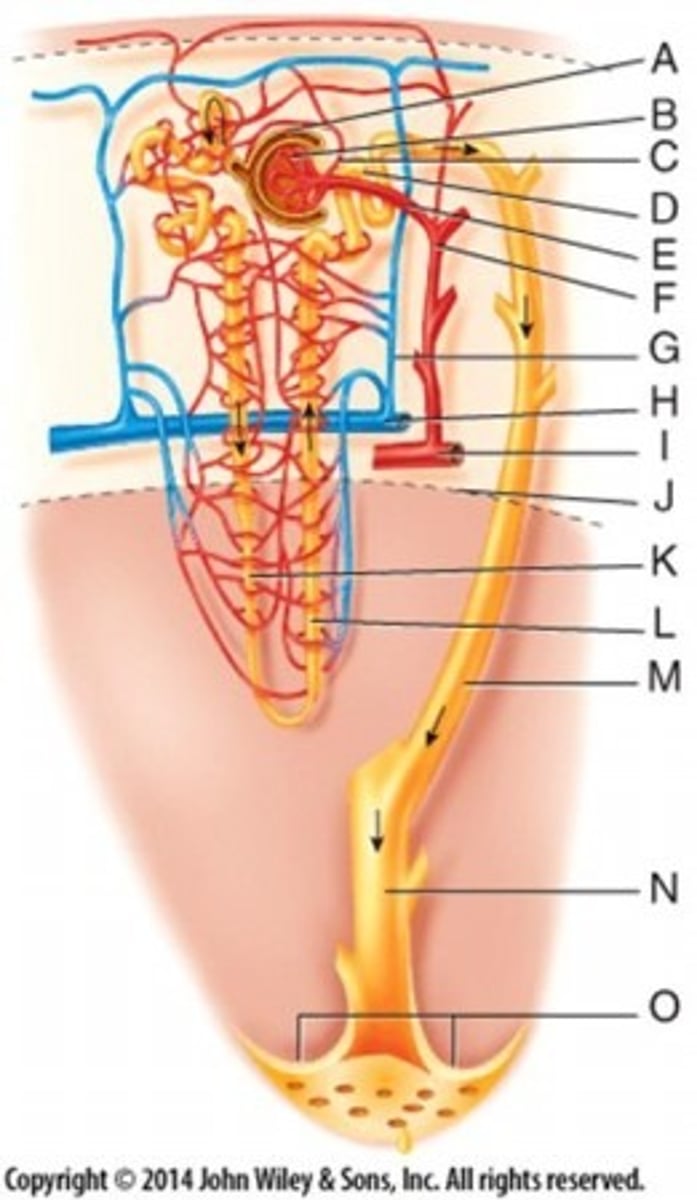
Where is the papillary duct?
N

The portion of the kidney that extends between the renal pyramids is called the
renal columns
3 multiple choice options
Where is the distal convoluted tubule?
D
3 multiple choice options

Fluid flowing from point N in the figure will go to which structure next?
G
3 multiple choice options
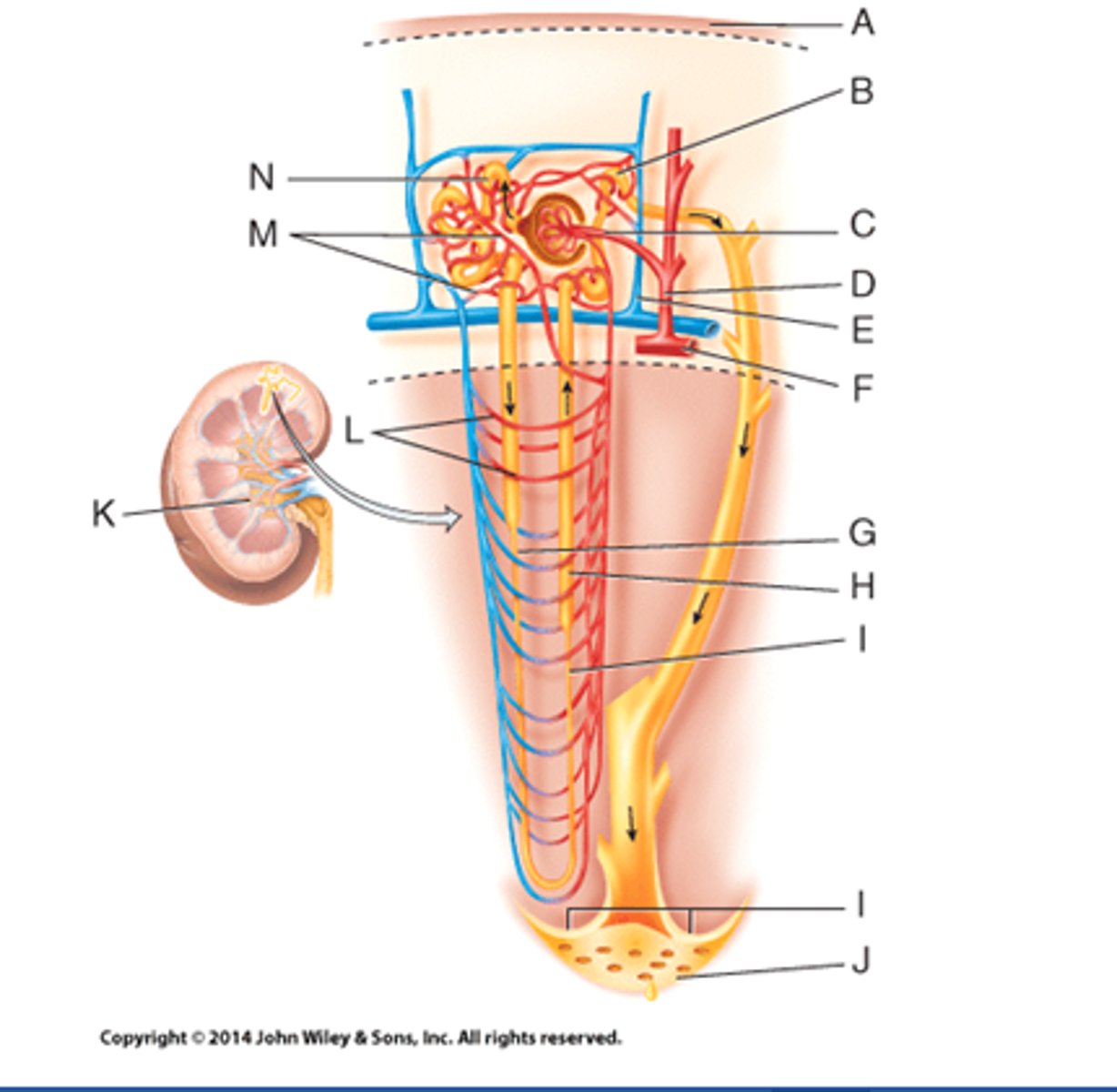
This is smooth dense irregular connective tissue that is continuous with the outer coat of the ureter.
renal capsule
3 multiple choice options
This is a nephron process that results in a substance in blood entering the already formed filtrate.
secretion
3 multiple choice options
What is line "B" pointing to?
pedicel
3 multiple choice options

What is line "C" pointing to?
filtration slit
3 multiple choice options

What is line "C" pointing to?
efferent arteriole
3 multiple choice options
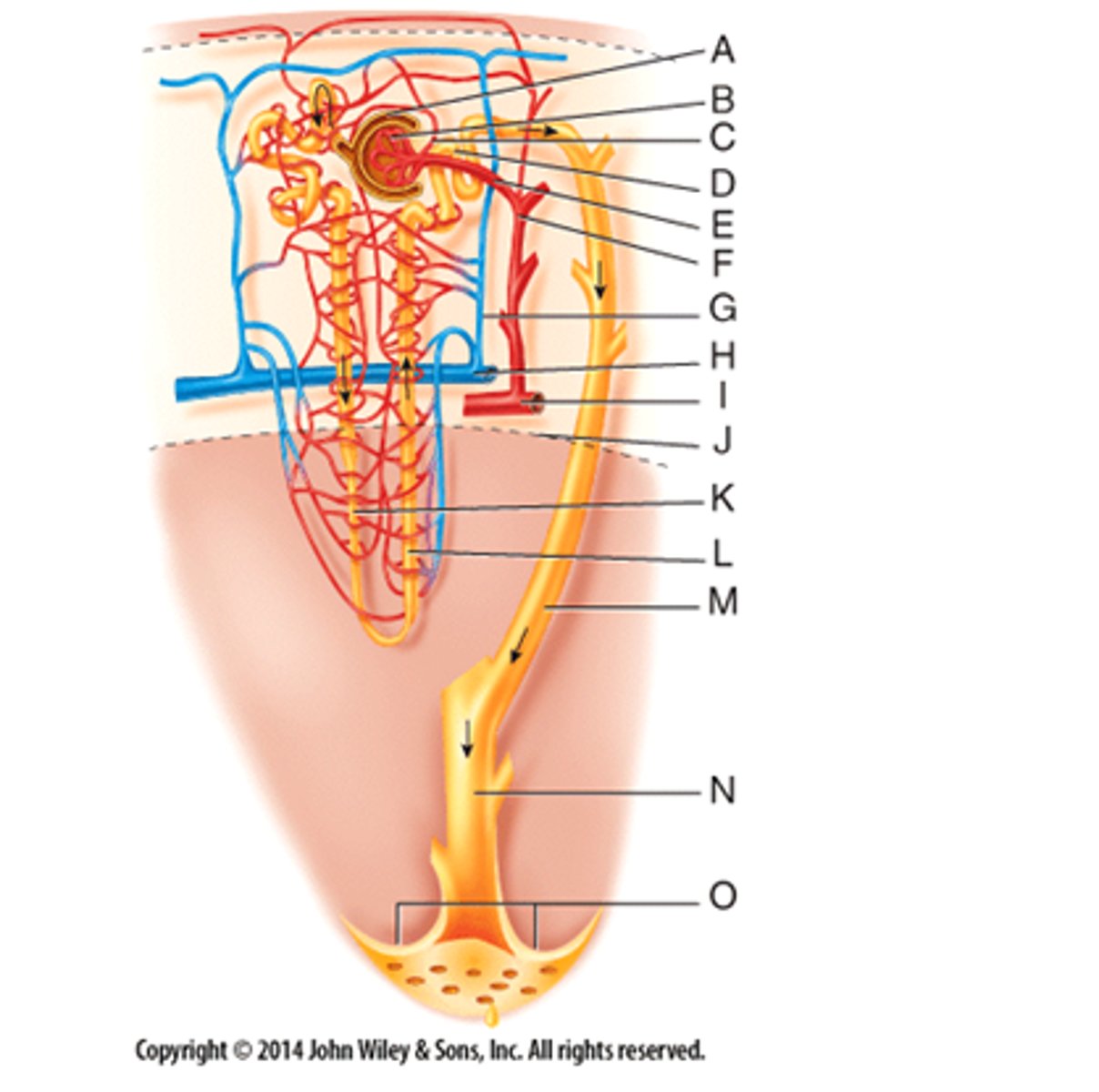
Urine formed by the nephrons first drains into these.
K
3 multiple choice options
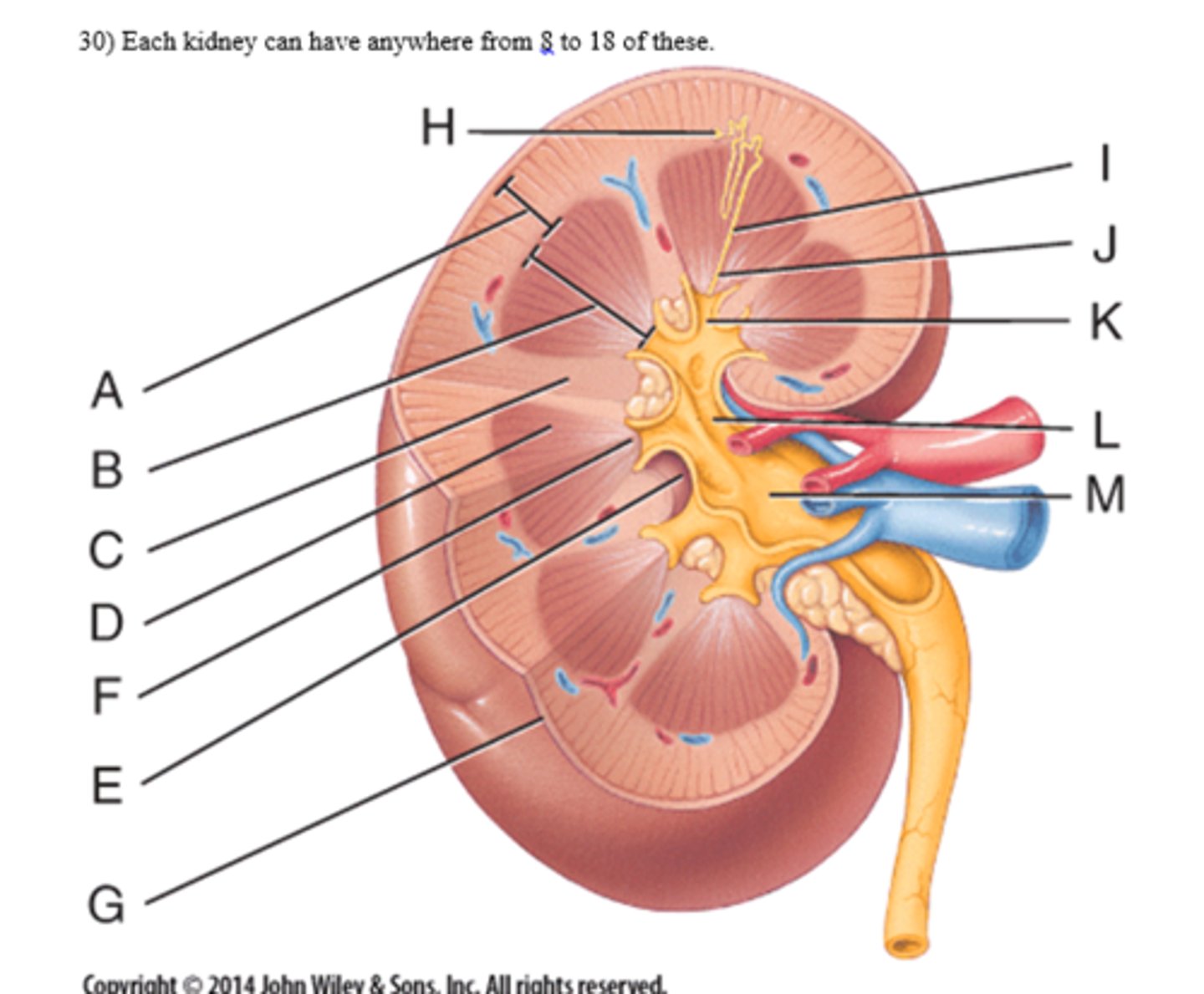
Which is the correct order of filtrate flow?
glomerular capsule, proximal convoluted tubule (PCT), nephron loop, distal convoluted tubule (DCT), collecting duct
3 multiple choice options
Where is the ascending limb of the nephron loop?
L
3 multiple choice options
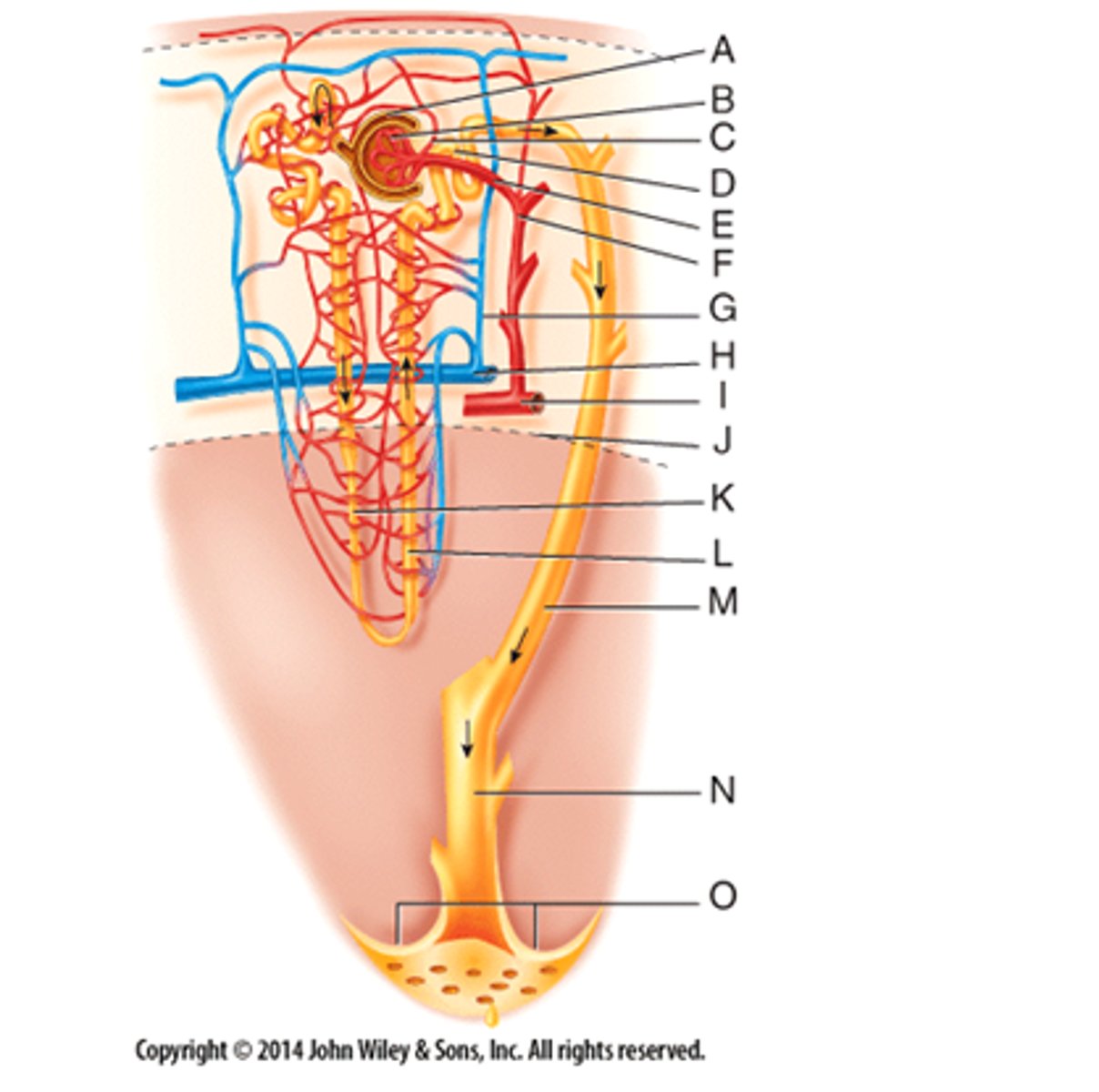
The hormone ANP is released from the heart and causes the urinary system to
increase urine volume and decrease blood volume
3 multiple choice options
When blood starts to become too acidic, the kidneys respond by
synthesizing and reabsorbing bicarbonate ions while secreting H+
3 multiple choice options
Which epithelium lines the ureters?
transitional
3 multiple choice options
Which is not a function of the kidneys?
Regulation of lymphocyte production
3 multiple choice options
Which number is labeling the region where most collecting ducts would be found?
5
3 multiple choice options
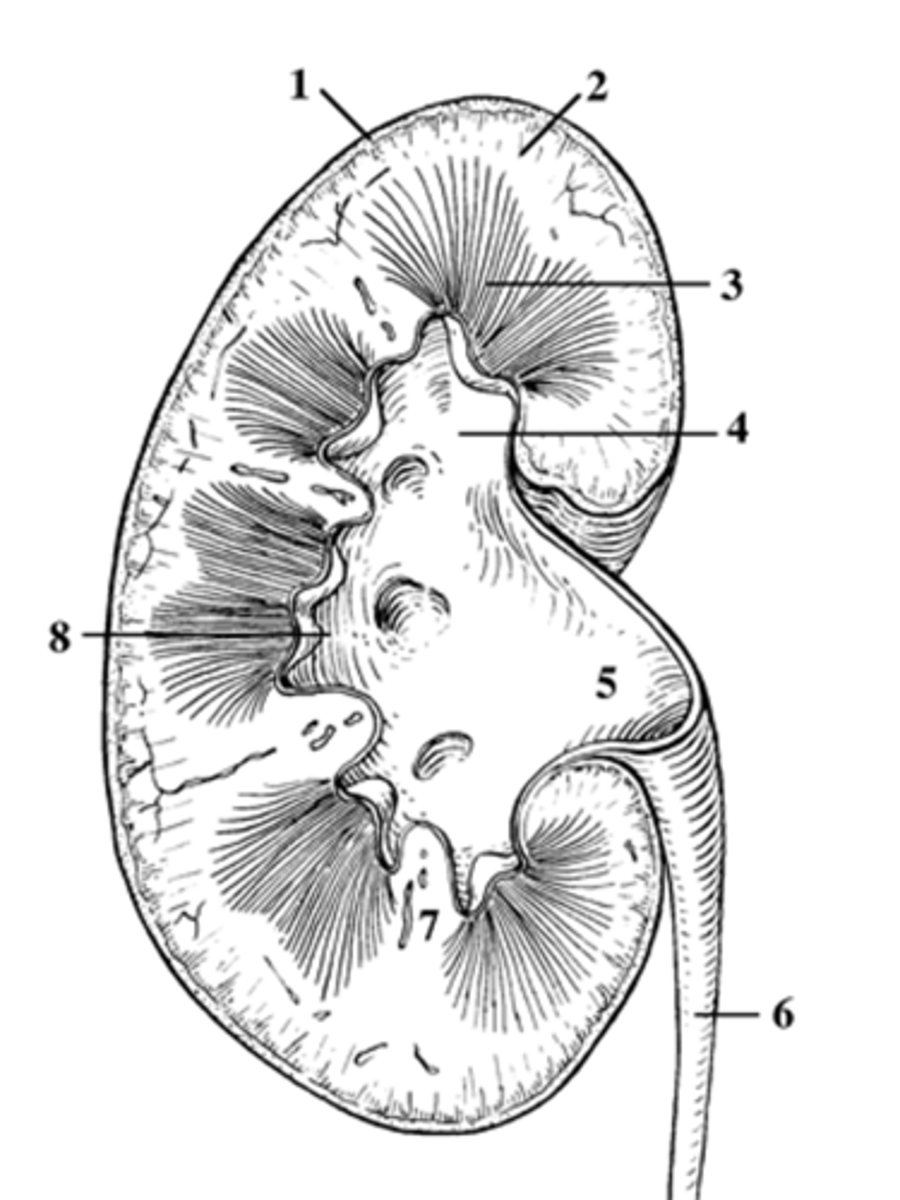
Healthy nephrons typically reabsorb 100% of the glucose they filter
true
1 multiple choice option
This figure shows a renal corpuscle. What structure does number 1 indicate?
efferent arteriole
3 multiple choice options

Which number is labeling the renal pelvis?
5
3 multiple choice options

Where is the distal convoluted tubule?
D
3 multiple choice options

Which class of nephron is crucially important in establishing a salt concentration gradient in the kidney so that urine concentration can be maximized?
Juxtamedullary nephrons
3 multiple choice options
Which number indicates the afferent arteriole?
1
3 multiple choice options
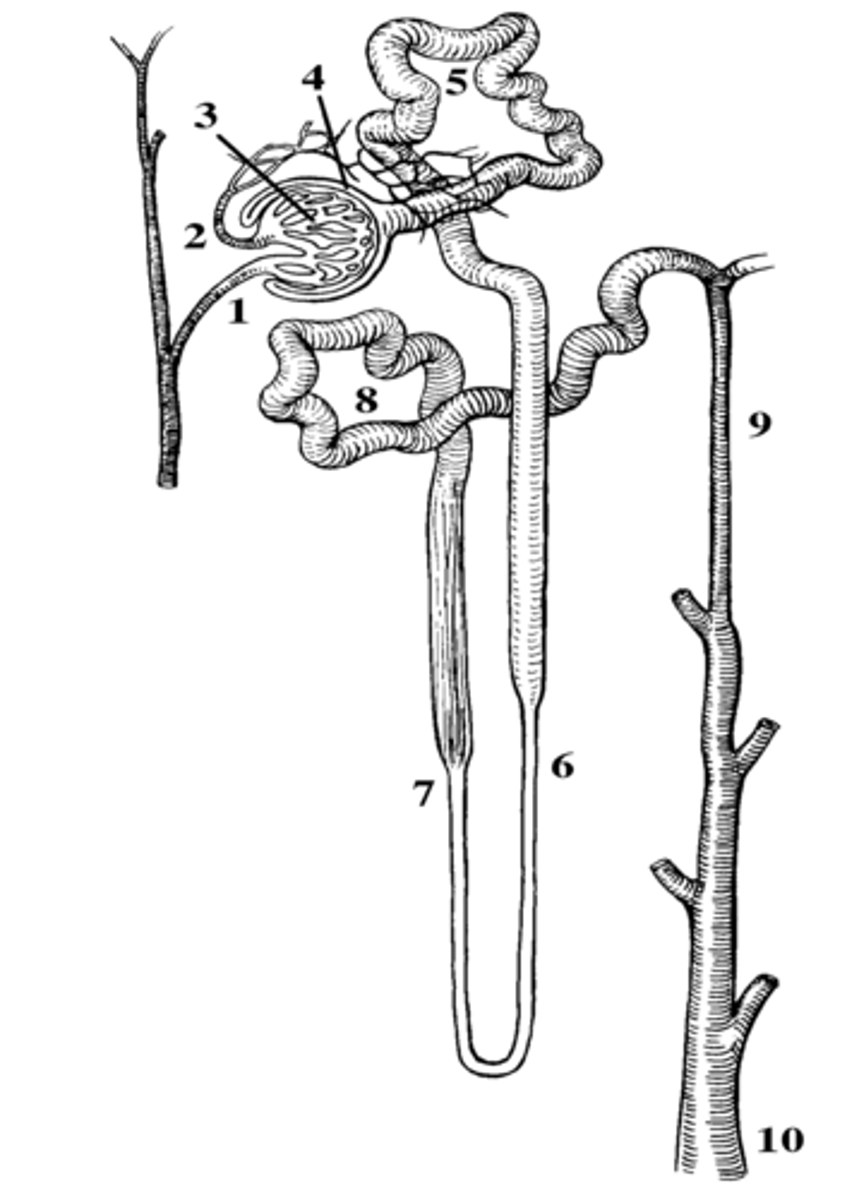
Place the regions of the nephron in the correct order for the process of urine formation.
a: Capsular space of glomerulus
b: Nephron loop
c: Collecting duct
d: Distal convoluted tubule
e: Proximal convoluted tubule
a,e,b,d,c
3 multiple choice options
Podocytes are cells with foot-like processes called pedicels. Podocytes are found in the
visceral layer of the glomerular capsule.
3 multiple choice options
The cortical tissue which extends between medullary pyramids is termed
renal column
3 multiple choice options
Which of the following is NOT a way angiotensin II affects the kidneys?
it increases GFR
3 multiple choice options
Increased secretion of hydrogen ions would result in a(n) ______________ of blood ____________?
decrease, ph
3 multiple choice options
Buffer systems, exhaling carbon dioxide and excretion by the kidneys, are all
Ways of controlling H+ levels in the body
3 multiple choice options
Which of the following occurs between RBC and blood plasma as the blood level of carbon dioxide increases or decreases?
chloride shift
3 multiple choice options
In intracellular fluid the most abundant cation is:
K+
3 multiple choice options
In extracellular fluid the most abundant anion is:
Cl-
3 multiple choice options
In extracellular fluid the most abundant cation is
Na+
Which of the following is used to promote water (only) reabsorption by the kidneys?
Antidiuretic hormone
3 multiple choice options
Which of the following is used to promote Na+ reabsorption by the kidneys?
Aldosterone
3 multiple choice options
Which of the following occurs when water loss is greater than water gain?
Dehydration
3 multiple choice options
Which of the following is a condition where blood pH is below 7.35?
acidosis
3 multiple choice options
Inadequate exhalation of carbon dioxide can cause
blood pH to drop
3 multiple choice options
Which imbalance results when systemic arterial blood HCO3- levels drop significantly (below 22 mEq/liter)?
Metabolic acidosis
3 multiple choice options
Which imbalance results when systemic arterial blood CO2 levels raise to abnormal values?
Respiratory acidosis
3 multiple choice options
Which of the following is the most common cause of metabolic alkalosis?
vomiting
3 multiple choice options
Which of the following is NOT a mechanism that maintains pH of body fluids?
All of these maintain pH of body fluids
3 multiple choice options
Which of the following is a common cause of respiratory acidosis?
Hypoventilation due to emphysema
3 multiple choice options
66% of the EXTRACELLULAR fluid (ECF) is
Interstitial fluid
3 multiple choice options
The corpus luteum is maintained by increased estrogen levels after fertilization.
false
1 multiple choice option
Study the sagittal section of the pelvis shown below. Which number is labeling the clitoris?
9
3 multiple choice options
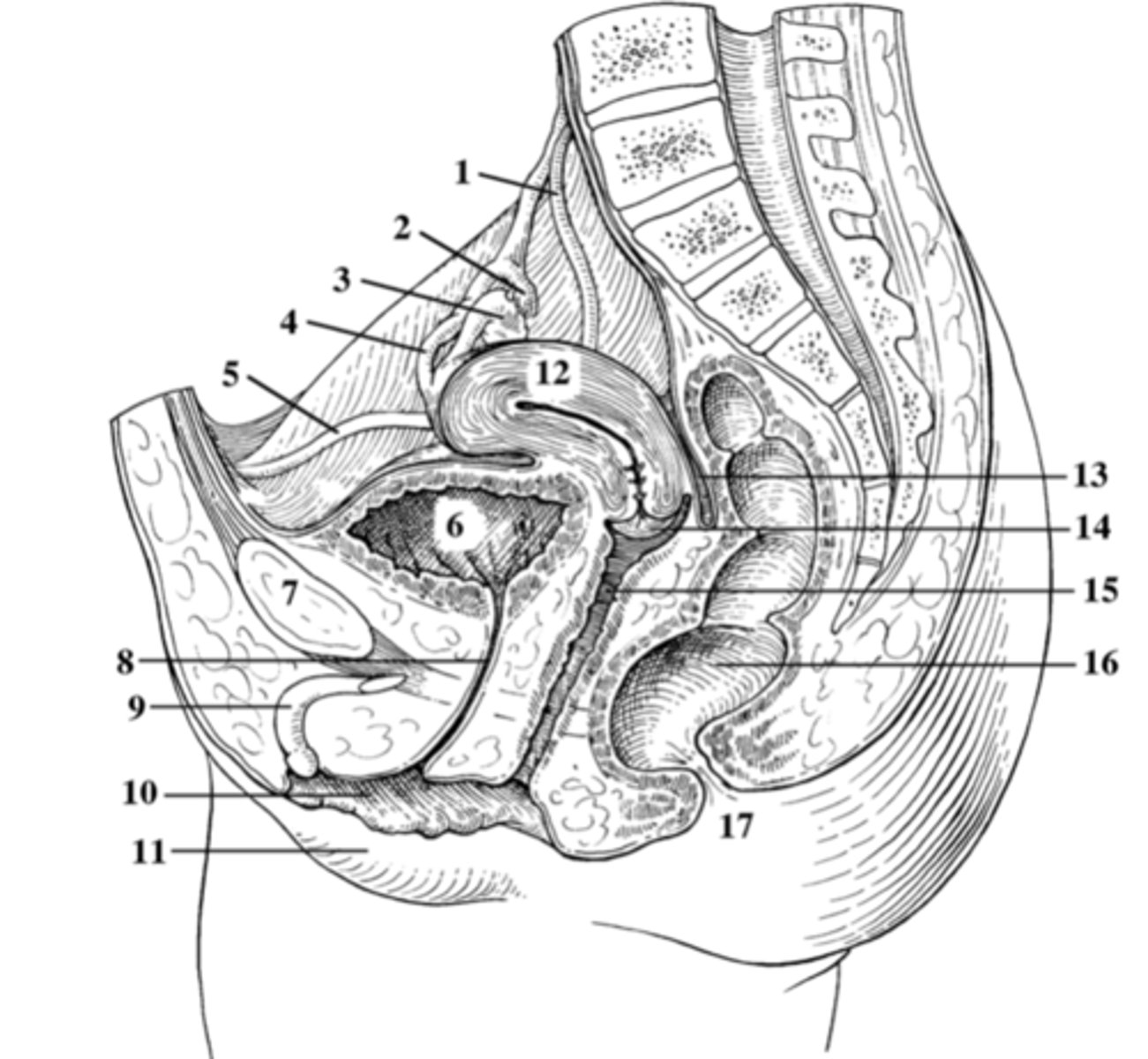
The male homologue to the labia majora is the
scrotum
3 multiple choice options
What is the correct order for the phases of the ovarian cycle, beginning with day 1?
Follicular, ovulation, luteal
3 multiple choice options
This figure shows a posterior view of the organs of the female reproductive system. Which number indicates the ovarian ligament?
2
3 multiple choice options

Study the pelvic image below. Which number is labeling the labia majora?
11
3 multiple choice options

Study the image. Which number indicates the ejaculatory duct?
14
3 multiple choice options

This figure shows a posterior view of the organs of the female reproductive system. What structures does number 6 indicate?
fimbriae
3 multiple choice options
A child has the same number of chromosomes as each of his parents. This is because the gametes that combined when that child was conceived each contained _____ chromosomes.
23
3 multiple choice options
A zygote typically has 46 chromosomes
true
1 multiple choice option
The structures of the male reproductive tract are
a: ductus deferens
b: urethra
c: epididymis
d: ejaculatory duct
e: ampulla
What is the order in which sperm passes through these structures from the testes to the penis?
b: c, a, e, d, b
c: epididymis
a: ductus deferens
e: ampulla
d: ejaculatory duct
b: urethra
The most common site of fertilization is the
ampulla of fallopian tube
3 multiple choice options
Ovulation is induced by a peak in the secretion of
LH (luteinizing hormone)
3 multiple choice options
The gonads
A. are the male testes and female ovaries.
B. secrete sex hormones.
C. produce gametes
.D. are dormant until puberty
.E. All of the choices are correct.
E. All of the choices are correct.
3 multiple choice options
What structure forms from the remnants of the follicle following ovulation?
corpus luteum
3 multiple choice options
A replicated chromosome consists of two identical structures known as
sister chromatids
2 multiple choice options
This figure shows the duct system in the male reproductive tract. Which number indicates the seminal vesicle?
3
3 multiple choice options

Menstrual flow contains dead perimetrial tissue
false
1 multiple choice option
This figure shows the duct system in the male reproductive tract. Which number indicates the ductus deferens?
6
3 multiple choice options
The secretory phase of the uterine cycle coincides with
the luteal phase of the ovarian cycle
A cell that contains 23 pairs of chromosomes is
diploid
3 multiple choice options
Examine the chart below. On which day on the timeline is a person most likely to become pregnant, and why?
Day 14; the rapid increase in estrogen triggers the release of Luteinizing Hormone from the anterior pituitary gland, which stimulates ovulation.
3 multiple choice options

Identify the highlighted structures and their correct role in the reproductive system
Uterine tubes; transport a fertilized ovum to the uterus.
3 multiple choice options

What is the name of the highlighted structure?
Epididymis
3 multiple choice options
Identify this structure and the tissue lining its lumen.
Vagina; non-keratinized stratified squamous epitheliia
3 multiple choice options